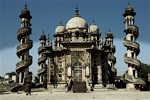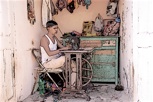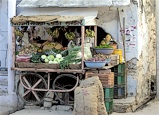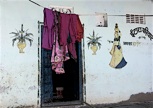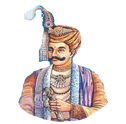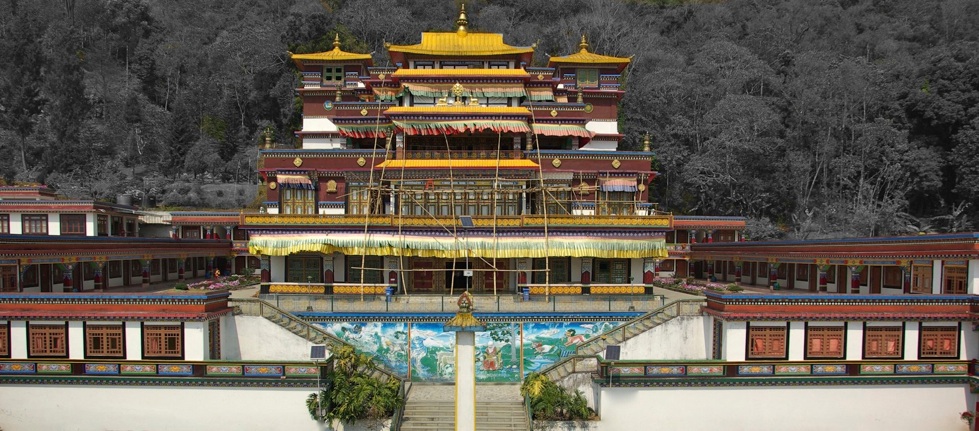
From Gujarat to Sikkim
Day 1 Departure from France on Emirates - Dubai Stopover 1:40 - 9 hours' flight
Day 2 Arrive Ahmedabad at 8:20. Welcome formalities: contact with the driver, delivery of vouchers. We do not change money at the airport, the rate is too low (1 euro = 65 rupees). We get a better rate at Western Union in the city: 1 euro = 71 rupees.
The driver did not speak English and almost seems to lead for a short time. It does not downgrade when the vehicle slowed, resulting in a lot of vibration, it struck a scooter whose occupants then try to fight.
Ahmedabad is the main city of Gujarat, approximately 6 million inhabitants, it is the sixth largest city in India. Once known for its concentration of textile mills and its important trade. It is also notorious for its recent clashes between Hindus and Muslims (2002, 2008)
After dropping the luggage at the hotel, we visit the Sabarmati Gandhi's Ashram built in the middle of a park on the banks of the Sabarmati River in 1917. We can visit the part occupied by Gandhi, another part has been converted into a museum. The location is peaceful and does not leave indifferent: it is filled with an energy that changed the history of India.
We discover Hriday Kunj, the house where he lived. Set of parts arranged in a U shape around a courtyard. At the rear of the house, on the right, a small annex, Vinoba and Mira Kutir lived from 1918 to 1921 by Vinoba Bhave, from 1925 to 1933 by Madeleine Slade, a British disciple Gandhi called Mirabhen English.
A little further to the right Nandini, the guest house, which hosted the visitors but also the disciples. Behind, Udyog Mandir, where Gandhi lived first at the creation of the ashram.
On the left, close to the river, the house occupied by Magan Niwas Maganlal, Gandhi's nephew, whom he regarded as the soul of the ashram.
It was here that Gandhi has launched his civil disobedience campaigns in the 1920s with the Khadi movement aimed at boycotting British products in promoting Indian handmade products (he himself spun yarn cotton on a spinning wheel ), and the salt March in March 1930 (Dandi March) to protest against the tax levied by the British on salt. He has traveled 313 km in 24 days with thousands of disciples to go to Dandi, on the edge of the Arabian Sea, to gather salt without paying tax.
Visit the Dada Hari Ni Vav, beautiful octagonal stair wells built in 1501. All the walls are carved. A group of women are dancing to celebrate a wedding. The color of the saree brightened this place a little spooky.
The driver then takes us to the Adalaj Tri Mandir (18 km from Ahmedabad). Huge marble temple can accommodate 10,000 devotees, built at the initiative of Ambalal Muljibhai Patel alias Dada Bhagwan a guru who has "received" universal knowledge on a station platform. It includes dozens of idols of gods and goddesses. Seems to be a sectarian movement. Little or listed in the guides, without much interest.
Road to Gandhinagar, about 30 km from Ahmedabad to visit the Akshardham temple. One of the most important temple of guru Swami Narayan. Imposing building, inside marble richly carved and decorated. Photos banned, no laptop or belt or handbag or backpack, because of attacks. It is called "no camera temple."
-
 Lunch at Green House (House of MG) gujaraties' specialties 498 rps / 2 obligatory donation for children included in the bill !
Lunch at Green House (House of MG) gujaraties' specialties 498 rps / 2 obligatory donation for children included in the bill !
Back to Ahmedabad to visit another temple of Swaminarayan. If all the temples of the guru look same, this one is a little different, it is very decorated and very colorful. Photos allowed. Free admission. Many families come to do pujas. Many activities, it would be his birthday. Contacts are friendly although very few people speak English.
Visit Hathee Singh Jain temple built in the year 1850 AD, marble smooth and shiny. It is famous for its intricate carvings that show musicians and other characters and symbols for Dharnmanath the apostle jain 15th century. Its founder Seth Hathee Singh was a prosperous merchant. The temple has a cement courtyard bounded by a line of cloisters containing 52 niches. Free admission Photos prohibited.
Day 3 Ahmedabad - Sihor - Palitana 218 km - about 4 hours
We decided to walk around the old town on foot, organized by the municipality: Heritage Walk, 50 rps / pax. Departure at 8.30 am from Kalupur end at 10:30 at the Juma Mosque Majid. The tour begins at the office with a slide. Visit the small temple of Swaminarayan which is opposite.
The "Routard" advises against this tour and proposes to do individually. The advantage of the organized tour is that target key points of interest, even if you can not see everything. You can get lost and spend more time searching for the path, passing by interesting things.
Pol is derived from the Sanskrit term patroli, which means "door or entrance." We enter each pol passing under an arch whose front wall has a window allowing people to see who came in and coming out, a massive wooden door is designed to stop intruders.
The oldest are 300 years old. Kind of villages "fortified" built by Hindus and Jains to protect themselves from other religious communities, they are true labyrinths. There would be hundreds in the city divided between the Jami Masjid Mosque and Sidi Bashir.
Many secret passages connect them. Each pol contains a temple, a bird feeder (Chabutaro) of character homes, today inhabited by artisans or ruin. Older homes offer balconies and facades carved wood, carved doors.
We discover the Lambeshwar or pol and the statue of the poet Kavi Dalpatram, Ramji Mandir private Temple in Haja Patel or Pole, or the Doshivada pol, the small temple jain Mandir Jagvallabh very interesting in its use of space, Nisha Pol, Zaveri Vad, Chaumukhji neither pol nor Sambhavnath kahadi, Astapadji Mandir, Harkunvar Shetani or haveli, the Fernandez bridge with its stalls of booksellers, the Manek Chowk and small shops.
In addition to all the small crafts that are themselves a real show, we are witnessing the preparations for a wedding.
The tour ends with a visit to the mosque Juma Majid, built by the city's founder, Ahmed Shah, about 600 years ago. The building reflects a particular style based yellow sandstone, the mosque has hundreds of pillars supporting a series of domes, a rare example of Islamic architecture of the 15th century. It recalls the Great Mosque of Kairouan representative of the period of the first centuries of the Muslim civilization founded in Apr 670. AD and rebuilt in the ninth century.
On the way back we pass the mosque Sidi Sayed, now closed, in front of the hotel House of MG, with famous semi-circular windows in stone's lace, one in particular was carved from a single rock .
Road to Palitana: we discover landscapes of fields of cotton and castor oil. Bajaj traditional rickshaws have been replaced by chhakda: a three-wheeled motorized rickshaw manufactured locally. It combines a Bullet motorcycle brand, the wheels of a small Fiat and a water pump walking with a diesel engine. It can carry up to thirty passengers and roll thirty-five km with one liter of diesel. It is the sound of a tiller, and the driver seems to stand so high up it is. One meets this type of rickhsaw in Gujarat.
We overlook Sarkhej Rauza built between 1442 and 1451 on the site where the holy Muslim religious leader Ahmed Ganj Baksh Khattu lived and died (in 1446). The site has a reputation for being poorly maintained.
Stop in the small town of Shihor or Sihor, formerly Sinhpur (187 km from Ahmedabad, 33 km from Palitana) off the beaten track. Buthas former residence of rich merchants of the 15th century. The old town has beautiful old wooden houses, not always well preserved that give it charm. Many small trades of yesteryear remain, very welcoming population. Many places photogenic.
Sihor is also known for prince Vijaya who lived there before moving to Ceylon and becoming the first king in 543-505 BC.
The seller of sweets, Mali Pendawala is so happy that we are interested in his work that he offers us Kaju Barfi, Indian dessert made with triangular paste of cashew nuts, milk and sugar, covered with a thin sheet of silver Varak or Vark. This is one of the most expensive desserts, reserved for ceremonies, weddings and other special occasions.
A visit to the Brahma Kund, an old step well in the 12th century built by Raja Jaisingh Siddharaj. The place has lots of charm.
We overlook Palitana and place of pilgrimage of Jainism, with its 863 temples built on top of the hill Shatrunjaya, accessible by stairs with 3950 steps (2:30 to climb, descend to 1:30) to do early morning. Photos banned in the temples.
Dinner at Vijay Vilas culinary specialties Gujaraties comprehensive 500 rps / 2
Day 4 Palitana - Gir normaly 202km approx 3:30
The driver imposes an early start. We see that it does not know the area and even less the language. He frequently asks for directions, do not understand what people say to him, and lost. We will do 340 km instead of 202 and will join the 7:00 to Sasan Gir hotel. Fearing that the rest of the trip is the same style, we ask to change driver for a driver who knows at least the region.
As we left early we arrive still in time for the first game.
No luck, the agency has failed to provide safaris. We are told it is too late to do the safari and will be reported on day after morning. But we arrived at 13:30 and safaris start at 15:30. The hotel is isolated, we can not do anything overnight.
-
 Lunch and dinner at the hotel buffet rice, dhal, vegetables, spicy. There is nothing outside.
Lunch and dinner at the hotel buffet rice, dhal, vegetables, spicy. There is nothing outside.
Day 5 Gir
Two safaris in the day, one at 7:30 and one at 15:30. Safaris last two hours and half. A fee of 500 rupees per camera is required. Each jeep has a driver and a guide. Which will prove completely useless, there are few things to see, the driver is able to explain what we see.
The Gir National Park makes a lot of publicity about the number of animals that can be observed. During the first morning safari, we saw four Sambars few chital, some monkeys Langurs, seen from far few crocodiles and some birds.
During the second afternoon safari, we saw two sambar, a dozen of chital, ten monkeys, five boars, two bee eaters and a lioness that we could shoot with a long lens.
The reputation of this park is overrated. Teak forest is sadly dry. Animals and birds are scarce. According to several forums, there is little chance of seeing lions. For Lonely Planet: one in two chance. We confirm, with a lot of luck and photo equipment appropriate.
Only interest of this reserve Maldhari breeders who live there, and an African community on the edge of the park, Sidhi, about nobody talks and give explanations. Who are they? Even them are unable to identify their origins. Were they slaves imported by Muslim invaders? Travelers who fled something or went on an adventure? Since when are they in India?
-
 Lunch and dinner at the hotel, the same meal as yesterday.
Lunch and dinner at the hotel, the same meal as yesterday.
There are probably more interesting to see in southern Gujarat that this reserve.
We meet the new driver.
Day 6 Gir - Junagadh - Jetpur - Gondal 140 km - approx 2:40
We were supposed to do the safari canceled on the first day, but the driver wants us to leave early, claiming that the road is long. We are at haggling, if we make the safari, we can not do by other scheduled visits.
We abandon the safari, and begin to regret having chosen this agency.
Drive to Junagadh, always in the middle of cotton fields and castor oil.
Visit the fort of Uparkot (free): Built at the foot of the Girnar hill, this fort was originally built in 319 BC. AD destroyed and rebuilt several times over the centuries, it was abandoned between the 7th and 8th centuries before being rediscovered in 976. Because of its strategic location, the fort was besieged sixteen times in 800 years. Near the ruins of the Jumma mosque built in the 15th century are caves dug by the man who had been occupied by Buddhist ascetics, to the 3rd century BC. Paying entrance, without interest.
Two Baoli (srep wells) Adi Kavi Vav and Navghan Kuvo throughout the trip, in a pitiful state.
After entering the city through the front door, we reach the Mahabat Maqbara mosque and the mausoleum of the vizier Bahaduddinbhai Hasainbhai. (Free)
Begun in 1878 and completed in Mahabat Khanji the year 1892 by his successor, Bahadur Kanji, the Mahabat Maqbara contains the tombs of Mahabat Khan, Baha-ud-din.
This is the visit to do in Junagadh. Original example of Indo-Islamic architecture which is reminiscent of a scene from Walt Disney: silver doors, ornate, minarets with exterior spiral stairs, hundreds of domes of various sizes ... we expect to see appear Aladdin and his magic carpet.
Drive to Gondal, enroute stop at the entrance of Jetpur known for its printed fabrics with block of wood, increasingly replaced by the screen printing industry.
Textile drying in the fields are already a "treat" for photographers. Screen printing is a printing method based on the stencil technique. What is industry is how to prepare the frame but the printing is done manually and still worth to be discovered.
Arrived at Gondal (at 13h - we would have had ample time to do the safari in the morning) we wanted to visit a khadi workshop (Udhyog Bharti Khadi Gramodyog) the driver has imposed another workshop in making us believe that it was the same.
-
 Lunch at Hotel Shree fried rice & noodles with vegetables 185 rps / 2
Lunch at Hotel Shree fried rice & noodles with vegetables 185 rps / 2
We visit the Ayurvedic Pharmacy (Bhuvaneshwari Ayurvedic Pharmacy Ghanshyam Bhuvan 9h-12h / 15h-17h)
Particularly interesting and surprising about level of hygiene conditions and preparation of remedies. We are far from our sanitized laboratories.
This visit led to a free consultation with an Ayurvedic doctor. We expected a consultation according to the rules of the art, in fact he just ask us what we wanted to treat and write prescriptions. Products are removed from the pharmacy of the temple. They cost double the product of an international brand known (Himalayas).
4th visit Swaminarayan Temple. Same decor, same atmosphere.
Day 7 Gondal - Rajkot - Morvi - Bhachau - Dhamadka - Dhaneti - Padhar - Ajrakhpur - Bhuj 277km approx 5h
Long road to Bhuj, through fields of cotton and castor oil. After Morvi road overlooking salt marshes, salt mounds of sight, as well as power lines.
We chose to go to Bhuj via Bhachau to visit the many crafts villages that lie between Bhachau and Bhuj.
Dhamadka: Village of block printing. Some Muslim families use this printing technique. Fabric and patterns are not very good. Colors are chemicals. We are surprised by the products offered for sale that do not look like what we have seen done in the workshops. Looks like prints by silkscreen ...
Dhaneti: Family Parmarth made embroidery. Except today because in mourning. Against by the shop works.
If these embroidery look perfect for traditional clothing, the colors of the fabrics and embroidery highly charged does not lend much to use Western.
Padhar: is known for Ahirs community embroidery including mirrors. While this is expected in our program the driver said he did not know and did not take us there. As he speaks little English, when he does not understand what we want, he closes and becomes nervous.
Ajrakhpur: village known thanks to Mohammad Ismail Kahtri, block printing specialist. The work is finer and searched.
The driver refused to go, saying that we had already seen the same thing in Dhamadka. We insist to go there because it is in our contract. This workshop do quality prints based on vegetable colors and works with Western countries. A team of designers Western is also at work to prepare a collection of fabrics.
Arrival at Bhuj in the early afternoon. Bhuj is a town devastated by an earthquake of magnitude 7.9 in January 2001 by 10 000 to 30 000 people. When you arrive at the entrance of the city, hundreds of families live in the hills in blue plastic tents in abject poverty. These camps are surrounded by garbage, debris, stray dogs. Everywhere we see piles of stones indicating that there had been houses.
-
 Lunch at Sankalp delicious meal from South India 355rps/2
Lunch at Sankalp delicious meal from South India 355rps/2
As we have time we propose to go Bhujodi to see carpet weavers of wool.
Instead of taking us into the village to see the workshops, the driver led us to Bhujodi Hiralaxmi Memorial Craft.
A shopping center for local and foreign tourists where are exposed different specialties of the region.
Beautiful objects in t different categories of crafts from Kutch, quite expensive and fixed prices.
Return visit to the fifth Swaminarayan temple. It is quite repetitive. Same architecture, same decor, same atmosphere.
The difference is that the drums and cymbals ceremony are driven by a motor and not by priests.
We begin to be annoyed by the "male" of 18 and 40 who follow us in the streets, in the temples to take pictures with their mobile phones. Their attitude, their persistence and their thoughts towards European women becomes painful.
This is the first time we pestered by men in India. At this level, the Gujarat seems very special !
-
 We eat in the canteen of the temple down on the right, for 40 rupees per person. Rice, dahl, vegetables and chapati, without too much chilli.
We eat in the canteen of the temple down on the right, for 40 rupees per person. Rice, dahl, vegetables and chapati, without too much chilli.
Day 8 Bhuj - Nirona - Zura - Loriya - Ludiya - Bhuj 180 km
We planned to spend the whole day visiting the communities living in the northern region of Kutch, to discover their characteristics and their craft.
Nirona: is the village of Gafurbhai Khatri family. For generations this family decorating fabrics with a special technique: the rogan painting. They use a flexible resin made by heating oil until it becomes thick and elastic, to which they added a dye. They apply this viscous colored paste with a pen of iron, without flattening. This creates raised designs on fabric, which when dry can not be removed it. Beautiful results.
Nirona is also the stronghold of Luhar Hussen Sidhik copper bell founder. In fact it's bells sheet metal on which they add copper ore they do melt in the oven. Initially these bells were for herds of goats and sheep, many in the region. Today they are rather reserved for tourists.
Nirona is also the village of a clan which one speaks little. They do remarkable work. Kaka Mala and her family from the community Wadhas "those who work with wood." They specialize in turning and lacquering of wood. Bed foots, stools, spoons, rolling pins, wooden spinning tops, bracelets holding, anything that can be turned and lacquered. They work with towers arc laid on the ground. They make themselves lacquer resins from plants and animals, and dyes. This community has a rather unusual history: http://madeinkachchh.wordpress.com/tag/nirona/
Zura: the driver said he did not know and did not go. He says he will show other villages in the region.
Loriya: the driver said he would take it on the way back.
To go to these villages it is not necessary to have a permit, as well as to go to the hotel Shaam-e-Sarhad Village Resort
Having planned to go to Ludiya, we have to go through the checkpoint Bhirandiara (50km from Bhuj) to withdraw the permit. It takes 15 minutes to complete the forms. Must provide a passport, photocopy of passport and visa. It costs Rs 100 per person (including the driver) + 50 rupees for the car. A year ago the permit in Bhuj was free!
The driver offers to take us to a village that turns out to be a showroom for tourists, in Bhirandiara. Some families of local communities (Bannis) built mud huts, decorated like tourism catalogs and selling crafts.
I ask to go to Ludiya. The driver refuses saying that this is the same thing.
After further negotiations we go to Ludiya, confident to find something else (according to some blogs). It's like Bhirandiara, freshly painted huts in the local style, transformed into shops for tourists, with women in traditional dress trying to sell their products. We are far from the craft for local use, both in terms of dress or everyday ware. This is only a production for tourism.
-
 Lunch at Shaam-e-Sarhad Village Resort excellent buffet 420 rps / 2
Lunch at Shaam-e-Sarhad Village Resort excellent buffet 420 rps / 2
Bhachau road and its villages, and the surrounding villages of Nirona seem very sufficient to discover the craft of Kutch.
As for the salt desert Dhordo "white desert" that the driver wanted to show us although we did not anticipate, it is not worth the 70km to do to get there and back (from Bhirandiara). This is irrelevant.
We return to Bhuj, bypassing Loriya, having no desire to negotiate again. We meet the procession of a Muslim marriage. We are invited to join them and share a moment of conviviality intense dancing in the street.
-
 Dinner at Nilan soup and vegetarian dishes 367rps / 2
Dinner at Nilan soup and vegetarian dishes 367rps / 2
Day 9 Bhuj - Dasada 276 km approx 4:45
Road to Dasada, in a thick fog. Arrival at 12:30. The driver has a free afternoon
-
 Lunch and dinner at the hotel Rann Riders included (there is nothing outside)
Lunch and dinner at the hotel Rann Riders included (there is nothing outside)
In the late afternoon jeep safari in the Little Rann Sanctuary, reserve of nearly 5,000 km2 and area of salt marshes inhabited by the Kolis community who exploit and commercialize salt.
In two hours we discovered more animals than in Sasan Gir : wild asses in the very special dress, the Blue Bulls nilgais with their unusual silhouette, eagles, pelicans, flamingos, cranes, foxes whiteleg, wolf and many birds.
Day 10 Dasada - Becharaji - Modhera - Patan - Sidphur - Danta 202 km
In Dasada, we were supposed to meet villagers of Rabari community and Mirs. Driver imposes again its timing.
Road to Becharaji known for the temple of Bahuchara Mata, a deity who rides a colorful chicken. Bahuchar Mata is a goddess invoked in case of disability, impotence, infertility. The goddess is also the goddess of hirjas (eunuchs) who flock in large numbers in the temple courtyard. Hijra are versatile characters, provoking behavior, even aggressive. The temple is pleasant to visit.
Continue to Modhera, on the banks of the river Pushpavati known for its Sun Temple, built in the 11th century, an example of Chalukya architecture found in southern India. This temple is dedicated to the worship of Surya, the "Sun God" which we know little. Blanks on the rear of the temple, erotic sculptures in poor condition.
The temple overlooks a beautiful stair wells Surya Kund which enhances its magnificence. The location and site quality are a must.
The grace of young women, the beauty of gestures, the atmosphere created by the natural decor give a harmony that shakes the time.
-
 Wait Park Way Restaurant Treat 193 rps / 2
Wait Park Way Restaurant Treat 193 rps / 2
Drive to Patan, an ancient fortified city built on the banks of the river Saraswati. Gujarat's capital for over 600 years (746-1411), Patan has more than one hundred Jain temples and magnificent old wooden houses. We ignore the Rani ki Vav Bâoli (step well) to take an interest in the old town.
Visit the Salvi family workshop representing the Patan Patola Heritage. All family members are involved in silk weaving on a double ikkat. The silk is dyed in advance depending on the grounds that you want to appear. It takes about 6 months to make a saree which cost more than 100,000 rupees, the preparation is more important than the weaving itself.
Discovering the old wooden houses, we also discover the life of the street with small shops, traditional crafts, and traditional games such as spindle moulder wtih string called Lattu that children handle with impressive dexterity, or Kancha like our game of marbles with small stones.
Continue to Sidhpur (sidhepur or sidhapur) we heard about Victorian havelis ...
What we expect exceeded what we can imagine. In the city center, broad, deserted streets, flanked by colorful houses with Victorian facades. With their columned porch and ground floor raised above street level, their balconies or windows in recess, and especially their pastel colors, these suggest some home district of London or the Painted Ladies of San Francisco.
The fact that the streets are deserted adds to the whole an ambiance of cinema decor ... we are no longer in India.
This area in the early 20th century was created by the community of Muslim merchants Bohras.
The Dawoodi Bohras, from Egypt and Yemen emigrants, arrived in India in the late 19th century by boat, after much persecution from Islamists who accused them of being too tolerant.
A strong community tradition mixed with an egalitarian sense influences the similarity of houses in many details: same size, same design, most houses look the same inside: 3 rooms in a row ending in a courtyard, with rooms upstairs. They are rarely more than one floor.
Despite all this stop we arrive early Danta. The Maharaja is absent, Maharanee Chandra takes us to visit Rabari village she likes. This village lives with breeding .
We note that in each house lives at least one woman whose face is covered. These are the daughters in law who must keep his face covered in the presence of the stepmother, and men outside the family. Custom that we already encountered in Rajasthan. Only married women wear bracelets. Unmarried girls do not wear and widows should break them from their widowhood.
Rabari men wear white clothes: the paghadi or pagari - white turban or colored depending on the occasion, the kediyum which is a kind of long sleeve shirt, bellows and lace, on which they sometimes wear a little white cotton jacket, dhoti or Chorni trousers draped that stop below the knees, silver bracelets, gold earrings, and an amulet around the neck to protect them from bad luck.
Rabari women wear the ghagra a long colored pleated skirt, a choli, bustier short sleeves revealing the belly or a backless blouse embroidered for married women, without embroidery for others. The odhni or odhna a long fabric which starts from the head, covers the back, pinchin the skirt. It gives the impression that they wear a saree. They wear jewelry to the feet and toes, ears and nose, and the bracelets on the arms.
The life of these villages is simple and sober. The arrival of a stranger brings a bit of animation. For us it is an opportunity to discover how do live these families who appreciate to get the photos were taken.
We then visit the stables of Maharaja who is passionate about horses, the cowshed that feeds his dairy, and gardens.
-
 Dinner at the Hotel Bhavani Villa Gujarati Thali 900 rps / 2
Dinner at the Hotel Bhavani Villa Gujarati Thali 900 rps / 2
Day 11 Danta - Ambaji - Poshina 111km 2h
Drive towards Ambaji 23 km 30 minutes, changing landscapes: since Danta we are in the presence of mountains Arawelli. The houses are hanging to hills, surrounded by small fields of wheat and corn, closed by ripe of stones or bushes. Everything is covered with green, crossed occasionally by a point of reddish rock.
On the road we met many processions, walking and sometimes from far away, join the Ambaji temple, ultimate sacrifice for the realization of a wish.
Ambaji is a holy place of Jainism booming because we are on the eve of the full moon. To visit the temple, handbags and backpacks, camera are not allowed.
Characteristic of the region, along the road from Danta to Ambaji, children sell bags filled with orange flowers they gathered in the trees: Butea monosperma or Flame of the forest. This flower has medicinal and culinary properties.
Road to Poshina 87 km approx 1:30
Arrived at 12pm to Poshina. Another free afternoon for he driver. Meeting with Gopal Singh last Maharaja of Poshina. His son no longer entitled to the title.
He tells us about his ancestors who reigned supreme over central India, and owned land on almost all the sub-continent. He also speaks of his spiritual life and his faith in the goddess who "lives" his private temple.
-
 Lunch and dinner at the hotel included. There is nothing outside.
Lunch and dinner at the hotel included. There is nothing outside.
In the afternoon, we were invited to join a Garasia village proceeding a funeral ceremony.
Over a hundred men and women are sitting in a field around family of the deceased. We are seeing rudimentary rituals that nobody can explain in English.
We are invited to take pictures until someone throw stones to us. This repeated shortly after during a visit to a family.
In same village we have seen a conflict between gangs of youths who threw stones violently.
When visiting a Garasia's house, there was a drum hung on the wall to alert when a conflict starts and invite the villagers to come to fight.
When our jeep stopped to ask the way, the young run away then return with stones in their hands.
A Dutch tourist, met in Poshina, says she attended a party where bows and arrows were stored, in case a brawl would trigger. Would Garasia be warlike people? It looks like !
End of the day to contemplate sacred places "inhabited" thousands of terra cotta horses. Beautiful modern pottery offered to a goddess in return for the fulfillment of a vow. Significant traces of blood on a rock suggest that there also practice animal sacrifice.
Early in the morning we were supposed to visit the village of Poshina accompanied by Jay an employee of the palace. The driver needed to leave early, while the ride is fast and short (Highway). He must drop us in Udaipur and return the vehicle to Ahmedabad. In fact he wants to return as soon as possible at his home. We urge the agency to intervene.
We visit the village as planned. It is very nice in the morning, because the light is softer, there are fewer people in the streets. Visit the potter, the blacksmith, the tailor. Visit the small village temples, Hindus, Jains, and discovery of cenotaphs of the royal family among the houses.
We leave for Udaipur at 9am and we arrived at 12:30. We meet the new driver for the Rajasthan part.
He takes a free afternoon.
-
 Lunch and dinner at the hotel Jaiwana for its terrace overlooking the lake and quality of its cuisine rps 450/2 and 640 rps / 2
Lunch and dinner at the hotel Jaiwana for its terrace overlooking the lake and quality of its cuisine rps 450/2 and 640 rps / 2
In the afternoon, great walking tour in Udaipur. Getting lost in the alleys, stroll on the banks of the lake and Gaths Pitchola, sit in front of the City Palace and let the imagination reconstruct its history ...
There are many more tourists than in 2009. It is impressive to see the effect this has on the city. There is not a place, not a house that is not transformed into restautant or guesthouse
There are plenty of false ayurvedic massage salons and ayurvedic products everywhere, trendy bars for "bobos", internet cafes and "baba fashion" shops.
Young Western look as they came out from a "rave party" in Goa or Vientiane: ultra sexy shorts, leggings and tight tank tops, beach flip flops.
Day 13 Udaipur - Roopangarh (Rupangarh) 350 km 4 h30
Road to Roopangarh, a small village nestled behind a enclosure three times centennial, which seem to be suspended outside of time.
On the road we wanted to stop at Pushkar, the only city that we have not yet seen in Rajasthan.
The new driver invokes the trip that takes more 16 km and ends by saying that it is not interesting, there are too many problems with tourists in the city.
-
 Mewar Restaurant parothas, and veg noodles 310 rps / 2
Mewar Restaurant parothas, and veg noodles 310 rps / 2
We capitulate and arrive to Roopengarh at 14h, which allows him to have a free afternoon!
The gigantic Roopengarh fort was built in 1648 by Maharaja Roop Singh of Kishangarh for the defense of the area. The fort was once used to protect the city. Although it is quite exceptional, it is not the fort which make interest in this step, but the village that surrounds it. Walking in the village until nightfall.
-
 Dinner and lunch the next day at the Fort, because there is nothing else outside Excellent vegetarian 750 rps / 2
Dinner and lunch the next day at the Fort, because there is nothing else outside Excellent vegetarian 750 rps / 2
As for the villages of Bassi and Bundi, this village is not frequented by organized tourism. Almost people speak English in small shops, workshops in neighborhoods.
If you take the time to sit and observe, to be present at what happens, communication sets, answers fuse, explanations organize, relations are shared to the point that at the end of the day one seems to have shared with everyone and understand a little better what each does.
There is a tailor every 20 meters, fabric sellers small grocers shops where there is nothing and there is a bit of everything, a dentist with a modern equipement working in approximate hygiene conditions, jewelers who manufacture "light" silver ornaments based on client demand.
There are also pharmacies that would frighten any doctor who sell pills to the unit, donuts merchants, sweets makers who perfume the air that makes you want to taste everything, mustard oil mills, a chai wala that at certain times walks the streets, his kettle in hand to serve tea to all those who call out, potters who sell these beautiful earthen round pots with geometric designs that we unfortunately can not put in suitcases
There is still the garlic and onions seller calmly sitting cross-legged on his cart, beside the brangles and nail polish seller, the vegetable seller with his cart worthy small market, and all these small vendors of spicy fried snacks like poori or namkeen bhujia who make wonder how they earn and how do they survive ...
Finally, there is all these old men playing cards on the floor, or on stools, some crowned with multicolors turbans, others wearing black waistcoats and white dothis, others sitting side by side smoking shilom passing from hand to hand, staring into wisps of smoke.
Roppengarh is India as imagined without its emergence, without the glitz of globalization, just life as it is ...
Day 15 Roopangarh - Bagru - Delhi 365 km - 5:30
Drive to Delhi, long but fast, it is a multi-lane highway with many tolls.
We planned to stop at Bagru (75 km from Roopangarh (1:15), on the road from Kishnagarh to Jaipur (35km)
The village is known for its printing bloks, its indigo dyes and fabrics that dry in nature. One of the only places where one is still hand printing in Rajasthan.
The driver confirms that he can not deviate from the route more than 16 km, he said he has never heard of Bagru, and that name does not even appear on the signs. I remember that it was in our program.
When I see the panel, large enough to be visible, I inform that Bagru is reported. He agrees to leave the Highway, provided that the village is nearby. Luckily, it is along the road.
We are looking for a workshop or a family practicing block printing or dyeing with indigo. When the driver get information, a man hears and starts to follow us on motorcycles. He stopped the driver, talk to him and guide him claims to be a block printing workshop.
It's a scam for tourists where two men pretend to print fabrics without the use of dye. It is grotesque! The goal was to bring us into a shop, we refuse to visit. Given the lack of motivation of the driver we do not try to do more workshops.
-
 Lunch at Maharani Midway veg noodle, veg cutlets 459/2
Lunch at Maharani Midway veg noodle, veg cutlets 459/2
We arrive in Delhi at 15h which allows the driver to have his afternoon free.
Day 16: Delhi - Bagdogra - Darjeeling 67km - 1h30 - approx 2200 m altitude
Departure for the airport. During the trip we express our complaints to the agency representative who accompanies us. We talk about the program that is not respected and planned visits must be negotiated with the drivers. He's sorry ! So do I !
1:15 flight to reach Bagdogra. Sitting to the left of the plane we see the Himalayas and its various peaks sharply. Impressive mountain that we enjoy to look closer. Welcome by the new driver loaded to visit this area. Hope he will be different !
Drive to Darjeeling via Sliguri. We go through tea plantations. Women are picking.
This is not the season of tea in Darjeeling, we will not have the opportunity to see picking people thereafter.
We double a convoy of thirty trucks of chemical fertilizers and pesticides. This gives an idea of the products that we'll find in our cups of tea!
Darjeeling road is in good condition and well studied: small stones are embedded in the bitumen to prevent vehicles from skidding. Very curvy road that crosses Kurseong, Sonada.
The first thing that strikes us is the difference in the gaze of men and the fact that everyone smiles. People in this area seem more cool and respectful.
Arrival in Darjeeling late afternoon. The sky is hazy, one doesn't see the Himalayan chain, nor the Kanchenjunga. Walk in Gandhi road and Chowrasta which is the city center. The only time we will be hassled was by local tourists soaked with alcohol.
Many shops for local and foreign tourists. Many fake antiques and more products made in china. The prices are quite high except in a small shop "Mandala" near to ShangriLa hotel. Some Buddhist objects of good quality, the owner does not want to tell stories about what he sells.
-
 dinner at Kunga restaurant the only one offering a real tasty Nepalese and Tibetan cuisine 355 rps / 2
dinner at Kunga restaurant the only one offering a real tasty Nepalese and Tibetan cuisine 355 rps / 2
Day 17 Darjeeling
Wake up early (4am) to go to Tiger Hill (13 km from Darjeeling - 2590 m) and watch the sunrise over the Kanchenjunga. The 20 rps ticket entitles you to hot tea.
Many local tourists capable of everything to take our place even though we arrived an hour before them. Their lack of respect becomes stressful.
The sun rises behind a thick veil of mist, Kanchenjunga is barely visible and appears very hazy 10 minutes before covering.
Visit the Yiga Choeling monastery of Ghoom dating from 1875. One of the oldest monastery in the region, where everything seems to have been frozen in time, with the exception of a recent construction on the right.
Beautiful golden statue of Buddha Matreya (the Buddha of the future). Very emotional moment for me, I have made my introduction to Buddhism there 40 years ago.
We then return to Darjeeling to take up Toy Train to Ghoom. That does not seem very logical in terms of organization ! We went few kilometers under the fly ash of an old breathless locomotive which can no longer climb the coast.
Stop at Batastia Loop which has no interest when the sky is overcast or foggy. An attraction for families with children.
Back to Darjeeling, visit the Tibetan Refugee Self Help Center opened in 1959 after the Chinese invasion with U.S. subsidies. The center includes several workshops crafts (weaving, dyeing, drawings and sculpture) where refugees from the first hour, their descendants, and the elderly or disabled are hard working.
We meet people who fled Tibet during the Chinese invasion. They crossed the Himalayas walk away and remember the cruelty of the Chinese, as well as events that have marked their exile. Many emotions, regret, revolt contained.
No visit Dhirdam temple (Hindu temple dedicated to Shiva) or the Japanese Peace Pagoda or temple of Mahakala, or plantation and tea factory as planned in our program.
The local agency had planned to take us to the zoo, to the Himalayan Institute Mountainering we did not want to see!
We refuse to go and express our regret to driver that our choices are not respected. He will talk about "the office." The driver dropped us off in town. He takes his free afternoon!
-
 Lunch at Kunga momos which are fabulous 237 rps / 2
Lunch at Kunga momos which are fabulous 237 rps / 2
Walk in the city in search of authentic Buddhist ritual objects. Difficult to find a place that is not a tourist shop.
-
 Dinner at Shangri La because Kunga is closed. Not the same kitchen, not the same clientele. 190 rps / 2
Dinner at Shangri La because Kunga is closed. Not the same kitchen, not the same clientele. 190 rps / 2
Day 18: Darjeeling - Kalimpong 50 km - 1h30 - 1250 m
Beautiful road to Kalimpong. We stopped a few kilometers from Darjeeling to admire Kanchenjunga, who deigns to make a shy appearance in the early morning. It is impressive, despite the fog that surrounds it.
The road is lined with pine forests and small villages full of charm.
22 km from Darjeeling discovering Lamahatta site and its eco-village. A space created to promote tourism and create a source of income for the villagers. The setting is pleasant with hundreds of prayer flags flapping in the wind, penetrated by sunlight in the morning.
-
 Lunch in a guesthouse unknown and isolated Tibetan soup 90rps / 2.
Lunch in a guesthouse unknown and isolated Tibetan soup 90rps / 2.
Arrival at Kalimpong in the early afternoon.
The agency plans to give us a tour of the sites that we did not want: a nursery, the Thongsa monastery which is irrelevant. We refuse to go. By cons we wanted to visit the Swiss Welfare dairy, cheese factory, and the market to discover the yak milk cheese. The driver told us that there is no yak in the region! He don't know the Swiss Welfare Dairy. Only Lonely Planet knows !
Visit Gangjong Paper Industry, against the bottom of the Hotel Silver Oaks, a workshop that manufactures paper with fiber from the bark of Daphne Bolhua deemed resist mold and insects. This paper is used by the monks for their sacred books. The factory does not work, it's Sunday. Most shops in the city are closed.
Visit the Zong Dog Fo Brang Palri (Durpin Gompa) monastery built in the 1970s. It stands on a high point of Kalimpong. Its interior walls are painted with frescoes. It shelters the Kangyur (the 108 volumes of Buddhist sacred texts) that the Dalai Lama took during his exile from Tibet in 1959.
At 15:30 we are witnessing a ceremony of prayers and pujas. Very impressive and paradoxical. The prayers of the monks emit vibrations that touch the soul. We discover a ritual gesture which accompanies the songs with great delicacy. Monks waving a bell (ghanta or drilbu), symbol of the feminine in one hand, and the other hand rotating the dorje or vajra symbol of masculinity.
The songs alternate with instrumental parts during which the sound of powerful dungchen (long horns bronze) is mixed with strident notes of gyaling (a kind of oboe), and the muffled sound of drums and rattling noise of cymbals, all in what seems to be a vast cacophony.
The young monks who are in the spans away from the center seem more concerned with candy, cans of sugary drinks, and heckling than by meditation. At the end of the ceremony, women offer large sums to each monk, even the youngest.
The faithful and the monks share a part of the offerings with us: candy; beverage cans, and tormas symbolic conical figurines made with tsampa (roasted barley flour) and yach butter.
Back to the hotel to 17h.
-
 Dinner at the hotel because there is nothing else, the city center is very far away. 230 rps / 2
Dinner at the hotel because there is nothing else, the city center is very far away. 230 rps / 2
Day 19: Kalimpong - Gangtok 72 km - approx 1:30 - 1850 m
Departure for Deolo Hill, hoping that this time we will have a clear view of the Himalayas and the Kanchenjunga.
En route visit the small monastery of Tharpa Choling established in 1922 which houses the Tibetan monks Yellow Caps (Gelukpa), from which comes the present Dalai Lama. Simple and rustic decor.
Deolo Hill will not be more exciting than Tiger Hill! No perceptible mountain on the horizon, even the river Testa on the right is barely visible because of the fog.
Down to the river Testa, we meet the Hanuman Mandir and pretty villages inhabited by colorful personalities, still wearing traditional clothes, plowing espaliers gardens, with ox plows equipped with a basis of bamboo.
The road following the river Testa to Rangpo is bad, as most of the roads of Sikkim.
Landslides, after the rainy season, would be the cause. The river's water is green jade, sometimes milky, sometimes transparent. The low sides, houses and vegetation along the road are gray with dust.
Stop at Rangpo for permit formalities: we need passport, a photocopy o fpassport and visa, a passport size photo. The permit is free for now. Formalities take half an hour.
On the road to Gangtok we head to the Rumtek Monastery. Before reaching Rumtek we saw indications to get to Ranka Lingdum Gompa.
We remind the driver that our program will go to Ranka. He gives us a choice between Ranka and Rumtek (both 45 km from Gangtok about 30mn driving).
We expected both because they are close. He says it is not possible and the road to go to Ranka is impractical.
Inquiry, it appears that the road is motorable. He must refer to his office. He does not understand why we want to see that monastery.
Contrary to what some books said we are not obliged to go walking from Ranka to Lingdom. Road is not different from other roads in Skkim. There is a large parking on the side of the monastery, local tourists use to go there by car.
The army is everywhere in this region. Always prevent a Chinese invasion.
Arrived at Ranka, we find (as the driver too) one of the largest and most beautiful Buddhist monasteries that we have seen in northern India.
Unlike the others, it is clean, quiet and refined decoration. It is home to 250 to 350 children monks from 6 to 18 years. There are everywhere, playing, horsing around, listening to pop music, between prayer sessions or lessons. Attend a ceremony at 7:30 or 15:30 in the monastery must be magic.
Small Buddhist souvenir shops, cheap but all made in china! Excellent Tibetan Nepalese restaurant.
-
 Lunch at restaurant Green Tara near the monastery soups and momos 170 rps/
Lunch at restaurant Green Tara near the monastery soups and momos 170 rps/
Drive back to Gangtok. We arrived at the hotel in the early afternoon, the driver takes his afternoon free.
We go into town on our own, 20 minutes awaywalking. The heart of Gangtok is surprising with its pedestrian streets MG Marg and flowers giving it the air of a small town in Austria. Fashion stores and traditional shops, trendy youth and women in traditional cross dresses, men wearing dhaka topi.
-
 Dinner at the hotel Hidden Forest the one offering a full meal, appetizer, main course, dessert 660 rps / 2
Dinner at the hotel Hidden Forest the one offering a full meal, appetizer, main course, dessert 660 rps / 2
Day 20 Gangtok
Either he thought, or he called his agency, the driver agrees to take us to Rumtek. If we did yesterday returning from Ranka would have saved us at least two hours.
Rumtek Monastery is surprising. Throughout the territory of the monastery is surrounded by a fence and armed guards. Must pass first gate invested by the police and the Indian Army. Control of passport, permits in Sikkim. A little above the monastery gate gives rise to a manual search and metal detector. The police women take a pleasure, barely hidden, to bring out all the contents of purses, camera bags, pockets.
The new monastery was built in 1966. It is the seat of the Kagyu and the Karmapa (black caps) It's the reason why it has been subject of attacks and fights from a dissident branch. Part of this school refuses to recognize the reincarnation of the 17th Karmapa and would impose another. The basis of the conflict based on interpretations of prophecies and signs validating reincarnation, on a background of Chinese interference and conflict of interest between religious chiefs. The rivalry plays between Urgyen Trinley Dorje and Trinley Thaye Dorje. We are far from the teachings of Buddha!
There are armed men everywhere in the monastery, we can not move around as we wish. The place is dirty, the decor is not very refined. We see many monks playing on their iPad or Galaxy, send SMS or phone with an iPod or smartphone, while others play foldable trottinett. Many wear Crocs or Nike instead of flip flops or sandals simple. All this seems far from the teachings of the Buddha.
Back to Gangtok to visit the Namgyal Institute of Tibetology (famous worldwide for his studies of Buddhist philosophy) where stayed Alexandra David Neel. Only the downstairs room is visited, some beautiful antiques. Here we pay for Buddhism introduction.
A little further on the right visit Chorten Do-Dru, which is the most visited stupa. It has nothing exceptional, Sri Lankan's stupas of are much more beautiful and interesting.
Visit Enchey Gompa Monastery 6 km from the center. The monastery attached to the Nyingmapa order, houses a hundred monks. Lama Druptok Karpo, a tantric master known for "flying", stayed there. In January or February, the monastery hosts the festival Detor Chaam with masked dances and music, two days.
Monastery is rustic, poorly maintained. The decoration is primary. We meet the younger monk met until now: Baichung, 4 years ...
The driver dropped us in town and takes his afternoon free.
-
 Lunch at Taste of Tibet Tibetan specialties, difficult to get vegetarian dishes 280 rps / 2
Lunch at Taste of Tibet Tibetan specialties, difficult to get vegetarian dishes 280 rps / 2
Walk into town in search of ritual objects that we have not found in Darjeeling. A shop with some antiques and other quality items at reasonable prices: Souvenir on MG Marg.
-
 Dinner at the hotel Hidden Forest the one offering a full meal, appetizer, main course, dessert 660 rps / 2
Dinner at the hotel Hidden Forest the one offering a full meal, appetizer, main course, dessert 660 rps / 2
Day 21 Gangtok - Bagdogra - Delhi 121 km + 1500 km
Start early to Bagdogra to take the flight back to Delhi. The road is very bad and work. Everything is gray, crowded. There were landslides everywhere. The mountain is very friable, in the rainy season it literally melts away everything in its path, houses, roads. This is the worst road met the entire circuit.
Day 22 Early Depart Delhi - France 8500 km
february 14th to march 07th 2013













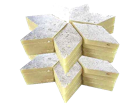
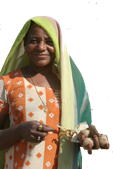


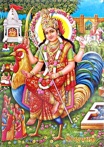



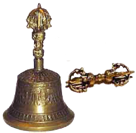


Orgyen Trinley Dorje
Trinley Thaye Dorje
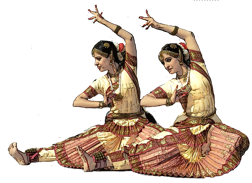
Ranka Lingdum Gompa
